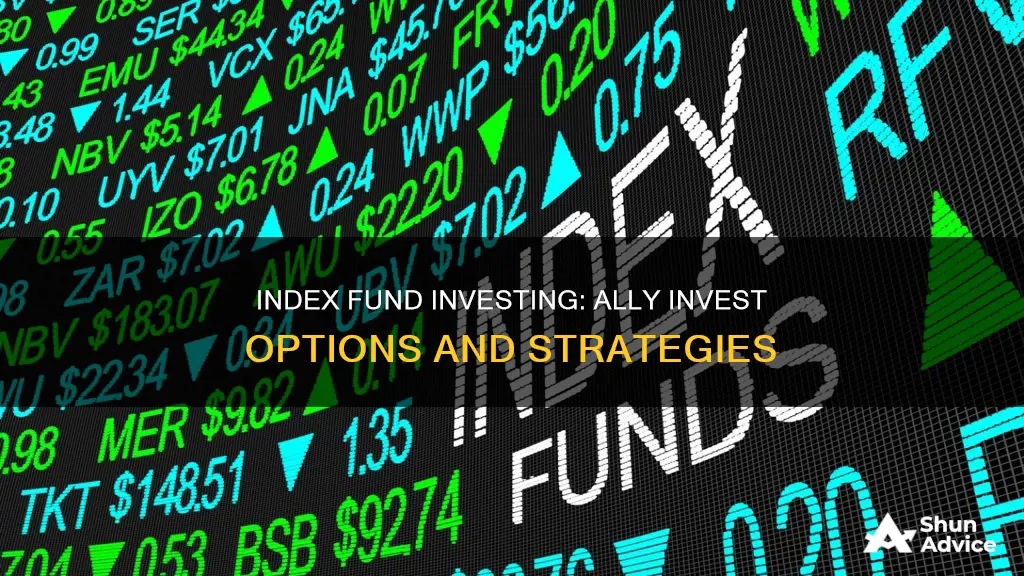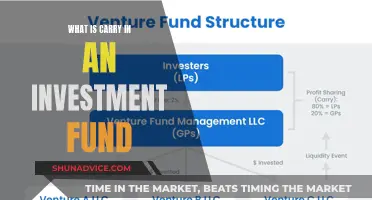
Index funds are a type of mutual fund or exchange-traded fund (ETF) that matches or tracks a market index. For example, an index fund may follow a benchmark index such as the S&P 500 or the Nasdaq 100. They are a popular type of investment because they allow investors to access a diversified bundle of stocks or mutual fund choices without paying the extra costs associated with a mutual fund. To start investing in index funds, you'll first need to open a brokerage account, such as Ally Invest's Self-Directed Trading account, through which you can make transactions for stocks, bonds, mutual funds, and ETFs.
What You'll Learn

Exchange-traded funds (ETFs)
ETFs are typically passively managed, meaning they aim to replicate the performance of a specific index or industry rather than having a portfolio manager actively select securities. This passive management style results in lower expense ratios compared to actively managed funds.
At Ally Invest, you can purchase ETFs through a Self-Directed Trading account or an Ally Invest Robo Portfolio. The former gives you more control, while the latter is a more hands-off approach.
ETFs are a cost-conscious choice, offering diversification with less risk. They allow you to invest in a particular sector, industry, or region without having to buy individual stocks. You can explore ETFs that align with your values and build a portfolio based on themes, causes, or companies that matter to you.
When evaluating an ETF, consider factors such as investment objectives, the index it tracks, its performance over time, expense ratios, and taxes. It's also essential to assess the management team's experience and track record.
Bond Fund Investment: What Percentage is Smart to Invest?
You may want to see also

Mutual funds
There are several benefits to investing in mutual funds. Firstly, they offer professional management, with experienced fund managers conducting research and making investment decisions on behalf of the investors. Mutual funds also provide diversification, allowing investors to spread their risk across a range of companies and industries. This helps to lower the risk of losing money if a single company fails. Mutual funds are also affordable, with relatively low initial investment requirements, and they offer liquidity, allowing investors to redeem their shares at any time.
However, there are also some potential drawbacks to investing in mutual funds. Mutual funds charge fees and expenses, such as annual fees, expense ratios, or commissions, which can reduce overall returns. Additionally, mutual funds may have a large cash presence in their portfolios, which can impact their performance. It can also be challenging to compare different mutual funds due to a lack of transparency in their holdings.
Overall, mutual funds can be a great way for investors to access a diversified portfolio of investments with professional management. However, it is essential to carefully consider the fees, risks, and potential benefits before investing.
Best Vanguard Funds for Your IRA: Top Picks
You may want to see also

Diversification
ETFs are a cost-effective way to diversify your portfolio. They are typically passively managed, aiming to replicate the performance of a specific index, sector, industry, or region. Each ETF includes a variety of securities, such as stocks, commodities, and bonds, allowing you to invest in a particular area of interest without selecting individual companies. ETFs are easily traded on the stock exchange during trading hours, providing flexibility and liquidity.
Mutual funds, on the other hand, are actively managed by fund managers who buy and sell securities to outperform the market. They pool money from numerous investors and invest in a variety of securities, providing instant diversification. While they have higher fees due to active management, they offer a more hands-on approach and the potential for above-average returns.
Both ETFs and mutual funds provide access to a diverse bundle of stocks or mutual fund choices, reducing the risk associated with individual stocks. When considering diversification, it's essential to examine your current portfolio, identify any gaps, and select investments that align with your financial goals, risk tolerance, and time horizon.
Additionally, when investing in ETFs or mutual funds, it's crucial to assess factors such as investment objectives, risks, charges, and expenses, which are outlined in the fund's prospectus. Understanding these factors will help you make informed decisions and build a well-diversified portfolio that suits your investment strategy.
Mutual Fund Investment: Planning for Retirement?
You may want to see also

Passive vs. active investing
Passive investing is an investment strategy that aims to maximise returns by minimising the costs of buying and selling securities. It is a long-term, buy-and-hold approach that seeks to build wealth gradually. Passive investors do not try to profit from short-term price fluctuations or market timing. Instead, they focus on the market's history of posting positive returns over time.
Index investing is a common passive investing strategy. Using this strategy, investors purchase the securities in a representative benchmark, such as the S&P 500 index, and hold them for a long time. Passive investing is typically done by investing in a mutual fund or exchange-traded fund (ETF) that mimics the index's holdings.
Passive investing is less expensive and complex than active management and often produces superior after-tax results over medium to long time horizons. It also simplifies the portfolio construction process and reduces fees triggered by frequent trading.
However, passive investing has some drawbacks. It offers less flexibility as investors are locked into specific holdings, regardless of market changes. It also tends to result in smaller potential returns as passive funds rarely beat their benchmark indices.
On the other hand, active investing takes a hands-on approach and requires a portfolio manager to actively research and decide which securities to buy and sell. Active investors aim to beat the market and deliver above-average returns. They are constantly buying and selling stocks to try to achieve this goal.
Active investing offers more flexibility as managers are not restricted to a specific index and can buy stocks they believe will perform well. It also allows for hedging and risk management strategies, such as short sales or put options. Additionally, active investing enables tailored tax management strategies.
However, active investing comes with higher costs due to transaction fees and analyst team salaries. It also carries a higher investment risk as managers are free to make costly mistakes.
Over time, passive investing has earned more money than active investing, and it has become the strategy of choice for millions of investors. However, active investing remains prominent, especially during market upheavals, as investors seek to take advantage of short-term price fluctuations.
HOA Funds: Where to Invest for Maximum Returns
You may want to see also

Index funds vs. mutual funds
Index funds and mutual funds are both investment vehicles that allow you to invest in a diverse portfolio of stocks, bonds, or other securities. However, there are some key differences between the two.
Index funds are a type of mutual fund or exchange-traded fund (ETF) that matches or tracks a market index, such as the S&P 500 or the Nasdaq 100. They are passively managed, meaning they attempt to replicate the performance of a specific index without much human intervention. Index funds are seen as less volatile investments because they are more diversified than individual stocks. They also tend to have lower fees and expense ratios than actively managed funds. However, they offer lower flexibility and choice, and you have less control over the holdings.
On the other hand, mutual funds are actively managed by a professional fund manager who makes investment decisions based on the goal of the fund. The fund manager's goal is to beat the market and deliver above-average returns to investors. Mutual funds usually have higher fees than index funds, which are bundled into the mutual fund expense ratio. Mutual funds also tend to require more research and have a higher potential for taxes. However, mutual funds offer more investment choices and the potential for higher returns in the short term.
When deciding between index funds and mutual funds, it's important to consider your risk tolerance, investment style, and financial goals. If you want a more hands-off approach, index funds might be a better option. On the other hand, if you want the potential for higher returns and more control over your investments, mutual funds may be more suitable.
Ally Invest offers two ways to invest in ETFs, which are similar to index funds in that they are passively managed and traded on a stock exchange: the Self-Directed Trading account and the Robo Portfolio.
Mutual Funds: Diversify Your Investment Portfolio and Reduce Risk
You may want to see also
Frequently asked questions
Index funds are a type of mutual fund or exchange-traded fund (ETF) that matches or tracks a market index. For example, an index fund may follow a benchmark index, such as the S&P 500 or the Nasdaq 100.
First, you'll need a brokerage account, such as Ally Invest's Self-Directed Trading account. Then, you can select an Ally Invest Robo Portfolio, which is primarily built on ETFs and is a more hands-off approach to investing.
Index funds are a popular type of investment because they allow you to tap into a diversified bundle of stock or mutual fund choices without having to pay the extra costs associated with a mutual fund. They also tend to be less volatile than individual stocks and can produce fairly predictable results over time.







